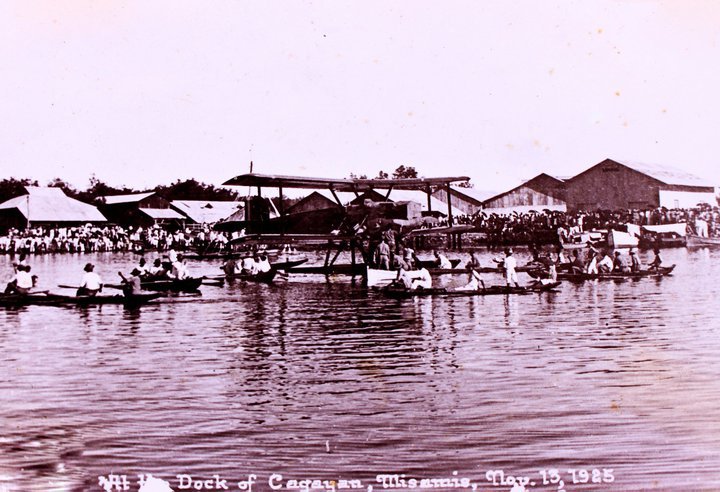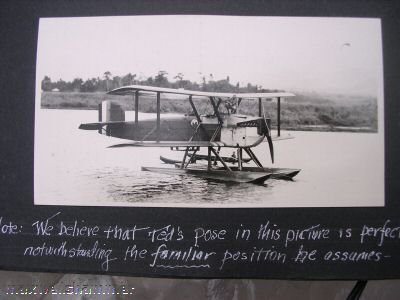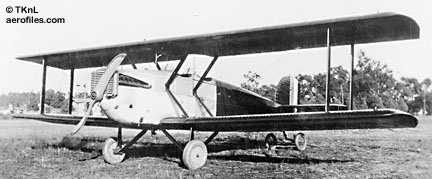Cagayan de Misamis’ first look at Aviation
On November 13, 1925 Cagayanons gathered at the Macabalan wharf to witness the arrival of the Douglas O-5, the same kind of aircraft that the United States used to fly in its attempt to be the first to fly around the world. The aircraft was then known as the Douglas World Cruiser.

The Douglas O-5 as seen in Macabalan Docks on Nov. 13 1925. Photo Credit: Ms. Nanette Roa Collection
The Douglas World Cruiser (DWC) was developed to meet a requirement from the U.S. Army Air Service for an aircraft suitable for an attempt at the first flight around the world. The Douglas Aircraft Company responded with a modification of their DT torpedo bomber. Five of these aircraft were ordered for the round-the-world flight, one for testing and training and four for the actual expedition.
The four expedition aircraft, named Boston, Chicago, New Orleans, and Seattle, departed Seattle, Washington on 4 April 1924 for the expedition around the world. The “Seattle” crashed into a mountain in Alaska on 30 April. The crew, Major Frederick L. Martin and Staff Sergeant Alva L. Harvey, survived and made their way through the wilderness to safety. The other three aircraft continued on through Asia, the Middle East, and Europe, relying on a carefully planned logistics system, including pre-positioned spare engines, to keep the aircraft flying. The “Boston” was forced down while crossing the Atlantic and damaged beyond repair while being recovered by the U.S. Navy light cruiser USS Richmond. The remaining two aircraft continued across the Atlantic back to the United States, where they were joined by the test aircraft, now christened “Boston II”. The aircraft returned to their Seattle starting point on 28 September 1924, 23,942 nm (44,342 km) and 175 days since departing.
After the success of the World Cruiser, the Army Air Service ordered six similar aircraft as observation aircraft, retaining the interchangeable wheel/float undercarriage, but with much less fuel and two machine guns in the rear cockpit. These aircraft were initially designated DOS (Douglas Observation Seaplane), but were redesignated O-5 in May 1924.]
On Friday November 13 1925, all classes in Cagayan de Misamis were suspended to allow the students and Citizens of Cagayan de Misamis to witness the arrival of two United States Army Air Corp Douglas O-5 in Macajalar Bay. From then on Cagayanons would refer to any plane as ‘edro or hydroplane which is another name for seaplane or float plane. A few months later, On January 17 1926 a Douglas O-5 (#24-7) on a Cartography mission piloted by Lt. Paul L. Williams would crash in Balingasag, Misamis Oriental. The O-5’s were based in Camp Nichols, Rizal.
Post Script:
“Hydroplane Crash” from the book “Historical Glimpses Of Old Balingasag” (1999) by Garcilaso Fernandez Vega: “On January 17, 1926, the people were surprised to see a flying object diving from one cloud to another and creating a sound totally strange to them. The object made acrobatic exhibitions to the delight of the people who watched with awe, and wondered how a non-bird could fly with such dexterity. Suddenly, the object became uncontrollable and smoke was seen coming from its tail. The flying object was a Douglas hydroplane, belonging to the United States Air Force. It crashed at Banuot as it hit a tall coconut tree. The pilot, a certain Lt. Williams, was able to free himself from the plane before it burst. He was unhurt.” The octogenarian author is a native of Balingasag who became a lawyer in 1953 & has made Davao City his residence. (Lino Juan Roa)






